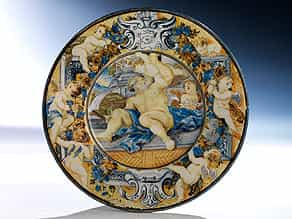Your search for majolika in the auction
Maiolica
Thursday, 27 June 2013
» reset
Your personal art agent

You would like to purchase a similar object?
We are happy to inform you, if similar works are to be auctioned in one of our upcoming auctions.
Please accept our privacy policy
588
Majolika-Teller aus der Werkstatt des Carlantonio Grue (1655 Castelli - 1723)
Durchmesser: 24 cm.
Castelli, Anfang 18. Jahrhundert.
Catalogue price € 22.000 - 25.000
Catalogue price€ 22.000 - 25.000
$ 23,760 - 27,000
£ 19,800 - 22,500
元 172,040 - 195,500
₽ 2,188,780 - 2,487,250
Teller mit breiter Fahne. Die Fahne zieren ein illusionistischer Rahmen, umwunden von Festons, in welchen Putti sitzen. Die Putti in der Fahne wenden sich erschrocken ab, nur einer blickt zur Szene. Der Spiegel zeigt Saturn, der sein Kind verschlingt und ein Putto mit Schriftband "FAME" (ital. Hunger oder Gier). Die Bemalung in Blau, Schwarz, Gelb, Grün und Orange. Bruchrest.
Anmerkung I:
Die literarische Grundlage liefert Hesiod. Saturn wird prophezeit, dass er durch seine Kinder entmachtet werden wird. Daraufhin frisst er sie auf, bis auf einen - Jupiter - der von seiner Frau versteckt wird. Jupiter entmachtet ihn und Saturn flieht nach Latium, wo er den Menschen den Ackerbau beibringt.
Anmerkung II:
Die Verkürzung und Untersicht, in der Saturn zu sehen ist, lässt darauf schließen, dass ein Deckengemälde als Vorlage diente. Pietro da Cortona stellte Chronos, seine Kinder verschlingend, im Palazzo Barberini, Rom, in sehr ähnlicher Weise dar. Es ist zu vermuten, dass nach dem Deckenfresko ein Stich angefertigt wurde, nach dem Carlantonio Grue arbeitete. Eine Zeichung mit einer ähnlichen Darstellung von Samuel Bottschild hat sich in der Staatlichen Kunstsammlung in Dresden erhalten.
Literatur:
Ein Teller von Carlantonio Grue mit einer vergleichbaren Rahmen-Gestaltung im Museum von Cluny, vgl. Jeanne Giacomotti, "Catalogue des majoliques des musées nationaux", Paris, 1974, S. 473, Abb. 1392. (9300047)
Maiolica dish from the workshop of Carlantonio Grue (1655 Castelli - 1723)
Diameter: 24 cm.
Castelli, beginning of the 18th century.
Dish with broad border. The border is decorated with festoons wrapped around a trompe l'oeil frame. In between the festoons are seated putti, all but one of whom averting their eyes in shock from the painted scene at the centre. The centre depicts the mythological scene of Saturn devouring his child and a putto holding a scroll that reads FAME (Italian: hunger or greed). Painted in blue, black, yellow, green and orange. Restored cracks.
Notes I:
Hesiod records this mythical scene. According to prophecy, Saturn was to be overthrown by his children, whereupon he would devour them all, apart from Jupiter who is hidden by his wife. Jupiter later overthrows his father. Saturn flees to Latium, where he teaches the people how to cultivate the earth.
Notes II:
The foreshortening and view of Saturn from below suggests that a ceiling fresco served as a model for this painting. Pietro da Cortona painted Chronos devouring his children in the Palazzo Barberini in Rome in a very similar manner. It can be assumed that the ceiling fresco was copied as an engraving, which served Carlantonio Grue as a model for his painting. A drawing with a similar illustration by Samuel Bottschild can be found in the collection of the Staatlichen Kunstsammlung in Dresden.
Literature:
For a dish by Carlantonio Grue with a similar frame design at the Museum of Cluny, see Jeanne Giacomotti, Catalogue des majoliques des musées nationaux, Paris, 1974, p. 473, plate 1392.
This object has been individually compared to the information in the Art Loss Register data bank and is not registered there as stolen or missing.
Your personal art agent
You would like to be informed of upcoming auctions if a similar work of art is offered? Activate your personal art agent here.
Please accept our privacy policy
You would like to purchase a similar object?
Your personal art agent Purchase in Private Sale Calendar
Our experts are happy to support you personally in your search for art objects.
You would like to sell a similar artwork in auction?
Consign now Private Sale Service FAQ
Your consignments are always welcome.
Our staff will be happy to personally assist you every step of the way. We look forward to your call.
Get in touch with our experts
further catalogues Furniture | 16th - 18th Century Paintings | Porcelain, silver, rock crystal | Library | Sculpture and Works of Art | Ceramics | Maiolica | Hampel Living | 19th - 20th Century Paintings | Russian Art | Modern Art | Asian Art, Jewellery & Watches | Books, drawings and engravings | Folk Art and Miscellaneous


















